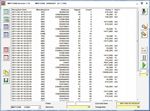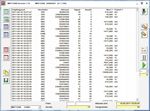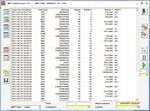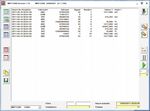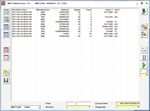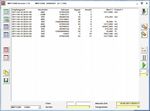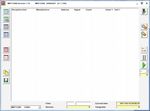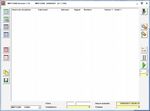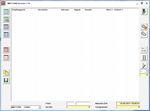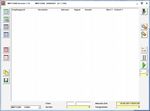MBWUSB Software Logiciel MBWUSB MBWUSB Software - User Manual Manuel d'utilisateur Benutzerhandbuch Version 1.21
←
→
Transcription du contenu de la page
Si votre navigateur ne rend pas la page correctement, lisez s'il vous plaît le contenu de la page ci-dessous
MBWUSB Software Logiciel MBWUSB MBWUSB Software User Manual Manuel d’utilisateur Benutzerhandbuch Version 1.21
© Michael Rac GmbH / Ansbach / Germany / 2008...2015 The name MBWUSB, the MBWUSB software and this manual are protected by copyright laws. Copying, translating, transferring to other media like microfiches and other electromagnetic or optical storage media without the written permission of the Michael Rac GmbH is prohibited. Trademarks or registered trademarks may be used throughout this manual. Even if it is not shown explicitly, they are protected by copyright laws and belong to their respective owners. The MBWUSB software and the accompanying documentation were developed with great precision and tested extensively for being free of errors. However, it might be possible that undetected errors appear. The Michael Rac GmbH is not liable for any incidental, indirect or consequential damages whatsoever regarding the MBWUSB software and this manual, the use of these products or the inability to use these products (including but not limited to, damages for loss of business profits, business interruption, loss of business information or any other pecuniary losses). The Michael Rac GmbH’s entire liability is limited to the price paid for this product. Michael Rac GmbH Am Hirtenfeld 51 91522 Ansbach GERMANY Email: mrg@michaelrac.com © Michael Rac GmbH / Ansbach / Allemagne / 2008...2015 Le nom MBWUSB, le logiciel MBWUSB et ce manuel sont protégés par des lois de copyright. Copier, traduire, transférer à des autres médias ou à des autres moyens de stockage électroniques ou optiques sans permission écrite de la société Michael Rac GmbH est interdit. Des marques déposées peuvent être utilisées dans tout ce manuel. Même si on ne l’indique pas explicitement, elles sont protégées par des lois de copyright et appartiennent à leurs propriétaires respectifs. Le MBWUSB, le logiciel MBWUSB et ce manuel ont été développés avec grande précision et ils ont été testés intensivement pour exclure toute erreur. Néanmoins, il pourrait être possible que des erreurs non détectées apparaissent. Dans toute la mesure permise par la réglementation applicable, la société Michael Rac GmbH ne sera en aucun cas responsable des préjudices directs, indirects ou consécutifs, qui résulteraient de l’utilisation ou de l’impossibilité d’utiliser ce produit (comprenant, mais non limité aux pertes de bénéfices, interruptions d’activité, pertes d’informations commerciales ou autres pertes pécuniaires). En toute hypothèse, la responsabilité totale de la société Michael Rac GmbH sera limitée au montant effectivement payé pour ce logiciel. Michael Rac GmbH Am Hirtenfeld 51 91522 Ansbach ALLEMAGNE Courriel : mrg@michaelrac.com © Michael Rac GmbH / Ansbach / Deutschland / 2008...2015 Der Name MBWUSB, die MBWUSB Software und dieses Handbuch sind urheberrechtlich geschützt. Jede Verwertung ist ohne Zustimmung des Herausgebers unzulässig. Das gilt insbesondere für Vervielfältigungen, Übersetzungen, Mikroverfilmungen und die Einspeicherung und Verarbeitung in elektronischen Systemen. In diesem Handbuch werden eingetragene Warenzeichen, Handelsnamen und Gebrauchsnamen verwendet. Auch wenn diese nicht als solche gekennzeichnet sind, gelten die entsprechenden Schutzbestimmungen. Das MBWUSB, die MBWUSB Software und die vorliegende Dokumentation wurden mit Sorgfalt entwickelt und auf ihre Fehlerfreiheit getestet. Dennoch ist es möglich, dass nicht erkannte Fehler auftreten. Die Michael Rac GmbH übernimmt keine Haftung für Schäden oder Folgeschäden, die im Zusammenhang mit diesem Produkt, bei der Benutzung dieses Produkts oder durch die Fehlbedienung dieses Produkts entstanden sind. Uneingeschränkt eingeschlossen sind dabei Betriebsunterbrechungen, Produktionsunterbrechungen, Personenschäden, Verlust von Daten oder Informationen oder jedwedem anderen finanziellen Verlust. Generell ist die Haftung auf den Betrag beschränkt, der für dieses Produkt bezahlt worden ist. Michael Rac GmbH Am Hirtenfeld 51 91522 Ansbach DEUTSCHLAND Email: mrg@michaelrac.com 2 MBWUSB
Table of Contents
English version 6
MBWUSB Software User Manual (English) 6
Introduction 6
System Requirements 7
Installation 7
Installation of the MBWUSB Software 7
Installation of the MBWUSB USB Hardware Driver 7
Starting up the MBWUSB Software 8
Elements of the MBWUSB software 11
The Main List 13
Settings 16
Firmware Update 18
Sending Radio Telegrams 20
Radio Telegram Coding / Decoding 22
Developing own Software 23
Table des matières
Version Française 24
Manuel d’utilisateur du logiciel MBWUSB (Français) 24
Introduction 24
Configuration requis 25
Installation 25
Installation du logiciel MBWUSB 25
Installation du pilote USB du MBWUSB 25
Lancement du logiciel MBWUSB 26
Eléments du logiciel MBWUSB 29
La liste principale 31
Réglage 34
Mise à jour de progiciel 37
Transmettre trames radio 38
Codage / décodage des télégrammes radio 40
Développer son propre logiciel 41
MBWUSB 3Inhalt
Deutsche Version 42
Benutzerhandbuch MBWUSB Software (Deutsch) 42
Einführung 42
Systemvoraussetzungen 43
Installation 43
Installation der MBWUSB Software 43
Installation des MBWUSB USB Gerätetreibers 43
Start der MBWUSB Software 44
Bedienelemente der MBWUSB Software 47
Die Hauptliste 49
Einstellungen 52
Firmware Update 55
Funktelegramme senden 56
Entwicklung eigener Software 59
4 MBWUSBMBWUSB Software User Manual (English) Introduction The MBWUSB is a radio receiver for M-Bus Mode T1, T2 and C1 resource meters with USB interface. It is used for mobile reading and meter testing purposes. The MBWUSB device comes with Windows software but also with a function library for self written meter reading software. 6 MBWUSB
System Requirements
Before installing the MBWUSB software, please check if your PC complies with the
minimum requirements:
• Windows 7, 8 or 8.1 operating system (updated to the latest version)
• 1 GHz processor
• 1 GB memory
• 20 MB free hard disk space
• 1 free USB port
• Internet connection (only once to install the USB driver)
Installation
Installation of the MBWUSB Software
The installation file MBWUSB_Setup.exe has to be started on your PC. While
installing the software the USB hardware driver for the MBWUSB is also copied to
your hard disk. The standard installation path:
C:\Program Files\MBWUSB
should be used, if possible.
If there is already a former version of the software installed, you have to remove this
version prior to installing the current version.
Installation of the MBWUSB USB Hardware Driver
The MBWUSB uses an USB standard driver, which is already installed on most
Windows PC. If this is not the case the automatic driver search mechanism of
Windows is downloading the current USB driver. However, an internet connection is
necessary in this case.
MBWUSB 7Starting up the MBWUSB Software The MBWUSB software is started up by double-clicking on the program icon on your desktop or by selecting its entry at the Windows start menu: Having installed the software for the first time, the following dialog for selecting the program language appears (English, French or German). Note: You may change the language afterwards on the settings dialog. The software recognizes automatically if a MBWUSB is connected to one of the USB ports of your PC or if it is disconnected. If there is no MBWUSB connected and the software is started, the window below appears: 8 MBWUSB
The software detects automatically the connection of a MBWUSB device and signals
this by printing its serial number in the program header line. Additionally, the button
for starting the radio reception is unblocked:
You may now directly click on the “start radio reception button” (green arrow). If there
are radio meter in the vicinity of the MTB1USB and the MTB1USB is able to decode
the telegrams, it shows the received radio telegrams in the main list on the window.
MBWUSB 9Elements of the MBWUSB software
The main program elements are shown beneath:
This button starts the continuous radio reception of all M-Bus T1, T2
and C1 mode meters in the vicinity of the MBWUSB. This button is only
enabled if there is currently no radio reception running and if a
MBWUSB device is connected. If not, it is disabled (grayed).
This button stops the continuous radio reception of all M-Bus T1, T2
and C1 mode meters in the vicinity of the MBWUSB. This button is only
enabled if the radio reception is currently running. If not, it is disabled
(grayed).
It is possible to preset a time period for receiving radio telegram
(between 1 minute and 12 hours). If the start button is pressed the
reception is automatically stopped when the time period has run out.
The lower field shows the remaining seconds. If you do not want to use
a time period but continuous reception select: .
This button invokes the program settings dialog which is described in
detail later.
This button invokes radio telegram coding / decoding dialog which is
described in detail later.
Is used to select the MBWUSB (automatic detection) or the COM port
for an MBWBLUE. For the MBWUSB it should always be set as shown.
MBWUSB 11It is possible to filter the output of the list in respect to the manufacture
code of the received telegrams (entry field on the left hand side) or to
the address of the received telegrams (entry field on the right hand
side). If e.g. a "1" is entered at the address field, only received
telegrams with an address field starting with "1" are shown in the list.
Clear both filter entry fields to show the complete list.
Current time shows the current PC time.
Shows the number of different radio meters received during the radio
reception.
Shows the total number of radio telegrams received during the radio
reception.
This button copies the contents of the main list to the Windows
clipboard. You may then paste the contents e.g. into Excel®.
This button saves the contents of the main list in a tabulator divided text
file. This type of file may be imported e.g. by Excel®.
This button closes the program. If the radio reception is running this
button is disabled (grayed) and it is not possible to terminate the
program. Stop the radio reception before terminating the program.
12 MBWUSBThe Main List
The main list is used to display the received radio telegrams in six different modes:
This buttons selects the user defined list of the received radio
telegrams. It is a subset of the detail list ( see below) where the
user has selected the columns to show.
This button invokes the user defined list setting dialog:
By selecting the appropriate columns the user may define its own list.
This buttons selects the detail list of the received radio telegrams. The
radio telegrams are interpreted and the values of the different telegram
fields are shown.
This buttons selects the hexadecimal list of the received radio
telegrams. The radio telegrams are shown in their hexadecimal form
without any interpretation (except the manufacturer and the radio meter
address).
MBWUSB 13This buttons selects the continuous list of all radio telegrams received
(whether detail list or hexadecimal list). Each radio telegram received is
added to the end of the list.
This buttons selects the sorted list of the radio telegrams received
(whether detail list or hexadecimal list). Each radio meter address has
got one entry and the entry is overwritten every time a newer radio
telegram arrives (the row “Count” gives the number of receptions).
The different columns of the main list are explained in detail beneath:
Detailed list:
14 MBWUSBReception time Date and time of the reception of the radio telegram
Manufacturer Manufacturer code of the radio telegram
Address Address field of the radio telegram
Signal Received radio signal strength indicator (0% ...100%)
Count Received telegram counter, in sorted list mode it shows the
number of reception of one specific radio meter.
Generation The generation field of the radio telegram (if available)
Medium The medium field of the radio telegram (if available)
CI field The CI field of the radio telegram
Transm. The transmission counter field of the radio telegram (if available)
Status The status field of the radio telegram (if available)
Signature The signature field of the radio telegram (if available)
Value 1
to Value 15 The transmitted meter counts. A maximum of 15 values are
decoded and listed. The meter counts are always recalculated to
base units, that is, a meter count e.g. in liter is recalculated to
m3.
Unit 1
to Unit 15 The physical unit of the transmitted meter counts.
Hexadecimal list:
Reception time Date and time of the reception of the radio telegram
Manufacturer Manufacturer code of the radio telegram
Address Address field of the radio telegram
Signal Received radio signal strength indicator (0% ...100%)
MBWUSB 15Count Received telegram counter, in sorted list mode it shows the
number of reception of one specific radio meter.
Telegram The received radio telegram in hexadecimal form. If the original
radio telegram was enciphered and the software was able to
decipher it, the deciphered telegram is shown. If the software
was not able to decipher the telegram, the original enciphered
radio telegram is shown.
Settings
The settings dialog is invoked by pressing the appropriate button. The
settings button is only enabled if the radio reception is stopped.
Deciphering keys The user may set 3 different deciphering keys for 64 bit and 128
bit, respectively. If a received radio telegram is enciphered the
software tries automatically to decipher it using all the
deciphering keys one after another. The 64 bit keys are used for
a manufacturer specific enciphering scheme, the 128 bit keys for
the AES128 enciphering scheme.
The deciphering keys are stored to the Windows registry to
preserve the setting after the program is terminated. However,
the Windows registry entries are enciphered using AES128
enciphering, therefore, it is not possible to read them from the
registry.
16 MBWUSBNotes for AES128 enciphering:
• The signature of the radio telegram must contain 0x05 in
the high byte.
• The high nibble of the low byte of the signature must
contain the number of enciphered 16 byte blocks (e.g.
0x0530 -> AES128 enciphering with 3 x 16 byte blocks)
• The AES128 enciphering is verified by checking the two
first bytes after the signature field. These two bytes must
contain 0x2F, 0x2F (M-Bus idle filler) to recognize a
successful deciphering.
• The AES128 enciphering uses cipher block chaining with
the following initial vector: 8 bytes of the address (from
manufacturer field to address field) + 8 times the
transmission counter
Language The program language may be set to English, French or German
Receiving Time The receiving time may be displayed in date / time format or in
microseconds (only for MBWUSB). The microseconds are based
on an MBWUSB receiver internal microsecond counter. You
have to restart the reception to change the receiving time format.
Address
Interpretation The program is able to decode the address field of a radio
telegram in different ways. The automatic setting tries to decide
automatically which address field representation is used.
However, in some cases this may not work. Therefore, it is
possible to force the address field interpretation to one of the
following schemes:
4 byte address – 1 byte generation – 1 byte medium
1 byte generation – 1 byte medium – 4 byte address
6 bytes number (LSB first)
SPDE [CNNCCNNNNN] (C=character, N= number)
6 bytes hexadecimal (LSB first)
List autoscroll Scrolls down the main list automatically with every received
telegram.
Not saved
Warning Displays a warning if the user starts a new radio reception
without having saved the existing data.
Decimal Whether to use a point “.” (e.g. 0.1234) or a comma “,” (e.g.
0,1234) as decimal divider.
MBWUSB 17Alternate Format This setting selects the radio capturing device used with the
MBWUSB software:
MBWUSB : MBWUSB devices 1.005 or below
BTREC
AM8425-MB
MBWUSB Long telegrams: MBWUSB devices 1.006 or above
The default setting is MBWUSB Long telegrams, however,
MBWUSB devices with firmware version 1.005 or lower are
not able to communicate if this options is selected. Use
MBWUSB or update the firmware of the
MBWUSB.
Firmware Update
If a later version than the current version of the firmware in the MBWUSB is
available, the MBWUSB may be updated. For the firmware update process the
MBWUSB must be connected to the USB port of the PC.
The firmware update control button is located at the settings dialog:
Using the control button Firmware update the MBWUSB is placed in update mode.
After approximately 1 second the software shows the message that the USB
connection to the MBWUSB must be disconnected for 4 seconds and then
reconnected again:
18 MBWUSBHaving done the disconnect / reconnect process, the start of the firmware update has
to be confirmed with OK. The process itself takes about 5 seconds and at the end the
disconnect / reconnect message appears again.
After disconnecting the MBWUSB from the USB and reconnecting it again the
firmware update has finished. The user may verify the update of the firmware version
by leaving the settings dialog, disconnecting the MBWUSB and reconnecting it again
to refresh the headline of the program with the current firmware version.
MBWUSB 19Sending Radio Telegrams
Using bidirectional radio devices (version number 2.x and above) it is
also possible to send radio telegrams to specific radio meters. This
function does not work for devices with version number 1.x.
Sending Mode Currently only wM-Bus Mode T2 is supported.
Sending Option Once / given address: If a radio telegram from the given
address is received the radio telegram
is sent once.
Always / given address: If a radio telegram from the given
address is received the radio telegram
is always sent.
Once / any address: If a radio telegram from any
address is received the radio telegram
is sent once.
Always / any address: If a radio telegram from any
address is received the radio telegram
is always sent.
Once / immediately: The radio telegram is sent once
immediately.
Chiprate [chip/s] The sending chip rate in chip/s.
20 MBWUSBReceiver address The address bytes field of the device which is to receive the radio
telegram. The address byte field contains 8 bytes from
manufacture code to device type. Instead of entering the address
field manually it is also possible to double-click on the list of
received devices if the list shows the radio telegram in
hexadecimal format:
Telegram to send The radio telegram in hexadecimal format. The telegram
must neither contain the preamble nor the synchronization word
of the radio telegram. The Manchester coding for wM-Bus mode
T2 is automatically done. Depending on the CRC options (see
below) the CRC field must be entered also or they are calculated
automatically by the software.
No CRC No CRC bytes are added to the telegram
CRC wM-Bus
format A CRC bytes according to wM-Bus format A are added
CRC wM-Bus
format B CRC bytes according to wM-Bus format B are added
MBWUSB 21Radio Telegram Coding / Decoding
Especially for developers there is a dialog for 3 of 6 coding and
decoding an M-Bus Mode T1 radio telegram.
It is possible to enter a radio telegram in binary form in the upper window. On leaving
the window (using e.g. the TAB-key) the lower window will show the 3 of 6 coded
version of the radio telegram.
Equally well a 3 of 6 coded radio telegram may be entered in the lower window and
the upper window will show the radio telegram in byte form.
22 MBWUSBDeveloping own Software
Using the accompanying function library it is possible to develop own software using
the MBWUSB device. The only file needed is MBT1ReceiverLib.dll.
If the functions of MBT1ReceiverLib.dll are used in conjunction with the MBWUSB
device, the file MBT1ReceiverLib.dll and the USB hardware driver information file
MBWUSB.inf may be distributed royalty free with your own software.
The MBT1ReceiverLib.dll is a COM module and has to be registered on the target
PC system, which is done by the Windows regsrv32.exe utility:
regsrv32 MBT1ReceiverLib.dll
After registration the functions encapsulated in MBT1ReceiverLib.dll may be used
by invoking the COM module.
The interface of the module is called:
MBT1ReceiverLib.MBWReceiver.1
IID: 9DF0B13A-8587-4C44-B584-BE209D51D647
CLSID: D4B4EC90-052B-422C-B8D3-F36197C7FC23
Please consult the Excel® macro example on the installation CD on how to read the
MBWUSB device:
MBT1ReceiverLib_ExcelMacroExample.txt
MBWUSB 23Manuel d’utilisateur du logiciel MBWUSB
(Français)
Introduction
Le MBWUSB est un récepteur radio pour des compteurs M-Bus Mode T1, T2 et C1
avec interface USB. Il est utilisé pour des relevés mobiles et pour effectuer des
essaies des compteurs radio.
Le MBWUSB est livré avec un logiciel Windows et aussi avec une bibliothèque de
fonction pour écrire vos propres logiciels de relevé.
24 MBWUSBConfiguration requis
Pour l’installation et l’utilisation de ce logiciel assurez-vous que votre ordinateur
répond au moins aux critères de la configuration minimale :
• Windows 7, 8 or 8.1 (avec les derniers Service Pack disponible)
• Processeur cadencé à au moins 1 GHz
• 1 Go de mémoire principale (RAM)
• 20 Mo d’espace libre sur le disque dur
• Interface USB
• Connexion internet (seulement une fois pour installer le pilote USB)
Installation
Installation du logiciel MBWUSB
Il faut lancer le programme d’installation MBWUSB_Setup.exe sur votre ordinateur.
Avec l’installation du logiciel le pilote USB du MBWUSB est aussi transmis sur votre
disque dur. C’est conseillé de ne pas changer le répertoire d’installation standard :
C:\Program Files\MBWUSB
S’il y a encore une version précédente de ce logiciel sur votre ordinateur il est
indispensable de le supprimer avant l’installation de la version actuelle.
Installation du pilote USB du MBWUSB
L’appareil MBWUSB utilise un pilote USB standard qui est normalement déjà installé
sur la plupart des ordinateurs Windows. Si ce n’est pas le cas la recherche de pilote
automatique de Windows va chercher sur internet le pilote adapté à votre Windows.
Cependant, une connexion internet est nécessaire.
MBWUSB 25Lancement du logiciel MBWUSB Le logiciel MBWUSB est lancé par double-clique sur le symbole de programme sur votre bureau ou par clique sur le menu Démarrer > Programmes > MBWUSB. Seulement au premier lancement après l’installation le dialogue avec le choix de langues (Français, Anglais, ou Allemand) apparaît : Note: Vous pouvez changer la langue du logiciel en utilisant l’option respective du dialogue de réglage. Le logiciel détecte automatiquement la présence ou absence d’un MBWUSB sur l’interface USB. S’il n’y a pas de MBWUSB connecté et le logiciel est démarré, l’affichage ci-dessous apparaît : 26 MBWUSB
Le logiciel détecte automatiquement la connexion d’un MBWUSB et il le signale par
l’affichage du numéro de série et de la version du progiciel dans le titre de la fenêtre.
En plus, le bouton pour lancer la réception radio est débloqué :
Maintenant vous pouvez directement cliquer sur le bouton Lancer la réception
(flèche verte). S’il y a des compteurs radio dans le rayon de réception du MBWUSB
et si le MBWUSB est capable d’interpréter les télégrammes radio, ils sont affichés
dans la liste principale de la fenêtre :
MBWUSB 2728 MBWUSB
Eléments du logiciel MBWUSB
Les éléments d’utilisation du logiciel sont montrés ci-dessous :
Ce bouton lance la réception radio en continue de tous les compteurs
radio de type M-Bus Mode T1, T2 et C1 dans le rayon de réception du
MBWUSB. Ce bouton n’est que débloqué s’il y a un MBWUSB
connecté et si la réception n’est pas encore lancé. Dans le cas contraire
le bouton est bloqué (gris).
Ce bouton arrête la réception radio en continue de tous les compteurs
radio de type M-Bus Mode T1, T2 et C1 dans le rayon de réception du
MBWUSB. Ce bouton n’est que débloqué si la réception est en cours.
Dans le cas contraire il est bloqué (gris).
C'est possible de régler un délai pour la réception des télégrammes
radio (entre 1 minute et 12 heures). Si le bouton de lancement de
réception est appuyé, la réception s'arrête automatiquement quand le
délai est éculé. La zone en bas montre les secondes restants. Si vous
ne voulez pas utiliser un délai de réception, choisissez : .
Ce bouton ouvre le dialogue de réglage qui est décrit en détail plus tard.
Ce bouton ouvre le dialogue de codage / décodage des télégrammes
radio qui est décrit en détail plus tard.
Cette liste est utilisée pour choisir le type d’appareil connecté. Pour un
MBWUSB il faut choisir l’option montré (détection automatique).
MBWUSB 29C'est possible de filtrer les liste des télégrammes radio selon les codes
de fabricant (zone d'entrée à gauche) et les adresses (zone d'entrée à
droite) des télégrammes radio reçus. Si p.ex. la zone d'entrée de
l'adresse contient le chiffre 1, uniquement les télégrammes radio avec
une adresse qui commence avec 1 sont affichées. Il faut effacer les
deux zones d'entrées pour afficher la liste des télégrammes radio reçus
au complet.
L'heur actuelle de l'ordinateur est affichée.
Affichage du nombre des compteurs radio différentes reçus pendent
une réception radio.
Affichage du nombre des télégrammes radio reçus pendent une
réception radio.
Ce bouton fait une copie du contenu de la liste principale dans le
presse-papier de Windows. Vous pouvez après coller le contenu du
presse-papier p.ex. dans un tableau Excel®.
Ce bouton enregistre le contenu de la liste principale dans un fichier.
Ce type de ficher peut être importé dans un tableau Excel®.
Ce bouton ferme le logiciel. Si la réception radio en continue est en
cours, ce bouton est bloqué (gris) et ce n’est pas possible de fermer le
logiciel. Il faut arrêter la réception radio avant de fermer le logiciel.
30 MBWUSBLa liste principale
La liste principale montre les télégrammes radio captés en six modes différents :
Ce bouton choisi l'affichage de la liste définie par l'utilisateur. Cette liste
consiste d'une partie de la liste détaillée ( voir ci-dessous) ou
l'utilisateur a sélectionné les colons a montrés.
Ce bouton affiche le dialogue pour régler l'apparence de la liste définie
par l'utilisateur:
En cochant les colons à affichés l'utilisateur défini l'apparence de sa
liste.
Ce bouton choisi l’affichage de la liste détaillée des télégrammes radio.
Les télégrammes radio sont interprétés et les valeurs des cadres
différentes des télégrammes sont affichées.
Ce bouton choisi l’affichage de la liste hexadécimal. Les télégrammes
radio sont affichés sans interprétation en format hexadécimal
(exceptions : code fabricant et adresse de compteur).
MBWUSB 31Ce bouton choisi l’affichage continue de tous les télégrammes radio
reçus (soit en détail, soit en format hexadécimal). Chaque télégramme
radio reçu est ajouté à la fin de la liste.
Ce bouton choisi l’affichage classée de tous les télégrammes radio
reçus (soit en détail, soit en format hexadécimal). Chaque compteur
radio n’a qu’une seule entrée dans la liste et c’est toujours le dernier
télégramme reçu d’un compteur qui est affiché (le colon « Nombre »
montre le nombre des télégrammes reçus d’un compteur).
Les colons différents de la liste sont expliqués en détail ci-dessous :
Liste détaillée :
32 MBWUSBHeure
de réception Date et heure de réception du télégramme radio
Fabricant Code de fabricant du télégramme radio
Adresse Cadre d’adresse du télégramme radio
Signal Indication de puissance du signal radio (0% ...100%)
Nombre Compteur des télégrammes radio reçus ; en mode liste classée
ce colon montre le nombre de télégrammes reçus par le
compteur respectif.
Génération Le cadre de génération du télégramme radio (si disponible)
Energie Le cadre d’énergie du télégramme radio (si disponible)
Cadre CI Le cadre CI du télégramme radio
Transm. Le cadre de compteur de transmission du télégramme radio (si
disponible)
Statut Le cadre de statut du télégramme radio (si disponible)
Signature Le cadre de signature du télégramme radio (si disponible)
Valeur 1
á Valeur 15 Les niveaux de compteur transmis. Au maximum les premiers 15
niveaux d’un télégramme radio sont affichés. Les niveaux sont
toujours recalculés aux unités de base, p.ex. si le niveau en
origine est en litre le logiciel affiche le niveau en m3.
Unité 1
à Unité 15 Les unités physiques respectives des niveaux de compteur.
Liste hexadécimale :
MBWUSB 33Heure
de réception Date et heure de réception du télégramme radio
Fabricant Code de fabricant du télégramme radio
Adresse Cadre d’adresse du télégramme radio
Signal Indication de puissance du signal radio (0% ...100%)
Nombre Compteur des télégrammes radio reçus ; en mode liste classée
ce colon montre le nombre de télégrammes reçus par le
compteur respectif.
Trame Le télégramme radio reçus en format hexadécimal. Si le
télégramme d’origine était crypté et le logiciel était capable de le
décrypter, le télégramme décrypté est affiché. Si le logiciel n’était
pas capable de décrypter le télégramme, le télégramme crypté
d’origine est affiché.
Réglage
Ce bouton ouvre le dialogue de réglage. Il est bloqué (gris) pendant la
réception radio.
Clefs de décryptage
L’utilisateur peut remplir 3 clefs de décryptage 64 bit différentes
et 3 clefs de décryptage 128 bit différentes. Si un télégramme
34 MBWUSBradio crypté est reçu le logiciel essaie automatiquement de le
décrypter en utilisant toutes les clefs de décryptage disponibles,
une après l’autre.
Les clefs 64 bit sont utilisées pour un algorithme de décryptage
spécifique au fabricant et les clefs 128 bit sont utilisées pour
l’algorithme de décryptage AES128.
Les clefs sont enregistrées dans les registres Windows pour que
l’utilisateur ne soit pas obligé de les remplir chaque fois le logiciel
est lancé. Cependant, les entrées dans les registres Windows
sont aussi cryptées en utilisant l’algorithme de cryptage AES128,
pour qu’il ne soit pas possible de les lire des registres Windows.
Notes pour le cryptage AES128 :
• Le cadre de signature du télégramme doit contenir 0x05
dans l’octet de poids le plus élevé.
• Le nibble de poids le plus élevé d’octet de poids le moins
élevé doit contenir le nombre de blocs de 16 octets crypté
du télégramme (p.ex. 0x0530 -> cryptage AES128 avec 3
x 16 octets blocs).
• Le décryptage AES128 est vérifié par les premier deux
octets après le cadre de signature. Ces deux octets
doivent contenir 0x2F, 0x2F pour signaliser un
décryptage correct.
• L’AES128 utilise en plus l’algorithme de cipher block
chaining avec le vecteur initial suivant : 8 octets de cadre
d’adresse (du code de fabricant au dernier octet
d’adresse) + 8 fois le cadre de compteur de transmission
du télégramme.
Langue L’utilisateur peut choisir l’Anglais, le Français ou l’Allemand
comme langue du logiciel
Heure
de réception L'heure de réception est affiché soit en date / heure soit en
microsecondes (seulement MBWUSB). L'affichage
microsecondes base sur un compteur interne du MBWUSB. Il
faut relancer la réception pour changer le format de l'heure de
réception.
Interprétation
d’adresse Le logiciel est capable d’interpréter le cadre d’adresse des
télégrammes radio en quelques façons différentes. L’option auto
essaie de trouver automatiquement la façon correcte pour
l’interprétation. Cependant, il est possible que l’algorithme
automatique échoue. Pour cette raison l’utilisateur peut aussi
choisir entre les options manuelles ci-dessous :
4 octets adresse – 1 octet génération – 1 octet medium
1 octet génération – 1 octet medium – 4 octets adresse
MBWUSB 35Numéro 6 octets (octet de poids le moins élevé au début)
SPDE [CNNCCNNNNN] (C=caractère, N= chiffre)
6 octets hexadécimaux (octet de poids le moins élevé au début)
Liste avance
auto. Avance la liste principale automatiquement avec chaque
télégramme reçu, pour que toujours le dernier télégramme reçu
soit visible.
Avertissement
enreg. Affiche un avertissement si l’utilisateur est en train de lancer une
autres réception radio sans avoir enregistrer les données
existante.
Décimale L’utilisateur peut choisir entre l’affichage de nombre avec un
point « . » (p.ex. 0.1234) ou avec un virgule « , » (p.ex. 0,1234).
Format alternative L'utilisateur sélectionne avec cette option quel dispositif de
réception radio est connecté:
MBWUSB : MBWUSB version 1.005 ou inférieur
BTREC
AM8425-MB
MBWUSB Télégrammes longs:
MBWUSB version 1.006 ou supérieur
MBWUSB Télégrammes longs est réglée comme option par
défaut, cependant, les MBWUSB avec un progiciel version
1.005 ou inférieur ne sont pas capable de communiquer si
cette option est choisie. Sélectionner MBWUSB
ou effectuer une mise à jour du progiciel du MBWUSB.
36 MBWUSBMise à jour de progiciel
Si une version de progiciel du MBWUSB plus récente est disponible, c’est possible
de le mettre à jour. Pour une mise à jour le MBWUSB doit être branché sur l’interface
USB de l’ordinateur.
La fonction de mise à jour est disponible sur le dialogue de réglage du MBWUSB :
Le bouton Mise à jour lance la mise à jour. Après environ 1 seconde le message
ci-dessous apparaît. Maintenant il faut couper la connexion USB avec le MBWUSB,
attendre environ 4 secondes et rebrancher le câble USB du MBWUSB :
Après on appuie sur OK et la mise à jour commence. La durée est environ
5 secondes et une autre fois le message à couper et à rebrancher la connexion USB
est affiché. Le processus de mise à jour est maintenant terminé.
Pour vérifier la mise á jour du progiciel il faut fermer le dialogue de réglage, couper la
connexion USB avec le MBWUSB et rebrancher le MBWUSB pour actualiser le titre
de la fenêtre principale du logiciel avec le numéro de série d’appareil et la version du
progiciel.
MBWUSB 37Transmettre trames radio
En utilisant une appareil radio bidirectionnel (version 2.x et supérieur)
c'est également possible d'envoyer des trames radio aux compteurs
spécifiques. Cette fonctionne n'est pas disponible avec les appareils
radio de la version 1.x.
Mode d'émission En ce moment seulement le wM-Bus Mode T2 est disponible.
Option d'émission
Une fois / adresse saisie : Si une trame radio du compteur
avec l'adresse saisie est reçue
la trame radio est envoyée une fois.
Toujours / adresse saisie : Si une trame radio du compteur
avec l'adresse saisie est reçue
la trame radio est toujours envoyée.
Une fois / adresse égale : Si une trame radio de n'importe quelle
compteur est reçue la trame radio est
envoyée une fois.
Toujours / adresse égale : Si une trame radio de n'importe quelle
compteur est reçue la trame radio est
toujours envoyée.
Une fois / tout de suite : La trame radio est envoyée une fois
tout de suite.
Chiprate [chip/s] La vitesse de transmission des données en chip/s.
38 MBWUSBAdresse de récepteur
Les octets de l'adresse du compteur radio à lequel il faut
envoyer la trame radio. L'adresse contient 8 octets (du code de
fabricant au type d'appareil). En lieu de saisir les octets
d'adresse manuellement on peut aussi double-cliquer sur la liste
des trames radio reçue si la liste montre les trames radio en
format hexadécimal :
Trame à envoyer La trame radio en format hexadécimal. La trame ne doit
contenir ni préambule radio ni mot de synchronisation radio. Le
codage Manchester pour wM-Bus mode T2 est fait
automatiquement en envoyant la trame radio. Dépendant de
l'option CRC (ci-dessous) il faut ajouter les octets CRC
manuellement où elles sont calculées automatiquement par le
logiciel.
Pas de CRC Il n'y a pas de CRC ajouter
CRC wM-Bus
format A Les octets CRC selon wM-Bus format A sont ajoutées
CRC wM-Bus
format B Les octets CRC selon wM-Bus format B sont ajoutées
MBWUSB 39Codage / décodage des télégrammes radio
Ce dialogue de codage / décodage 3 sur 6 d’un télégramme M-Bus
Mode T1, T2 et C1 est disponible spécialement pour les développeurs.
Il est possible d’entrer un télégramme radio en format binaire dans la zone d’entrée
supérieure. En sortant la zone d’entrée supérieure (par la touche TAB) la zone
d’entrée inférieure affiche le télégramme en format 3 sur 6.
Egalement un télégramme radio en format 3 sur 6 entré dans la zone d’entrée
inférieure est traduit en format binaire dans la zone d’entrée supérieure.
40 MBWUSBDévelopper son propre logiciel
Avec la bibliothèque de fonction sur le CD d’installation il est possible de développer
son propre logiciel de relevé pour le MBWUSB. On a seulement besoin du fichier
MBT1ReceiverLib.dll.
Si la bibliothèque de fonction MBT1ReceiverLib.dll est utilisée avec l’appareil
MBWUSB, le fichier MBT1ReceiverLib.dll est le pilote USB MBWUSB.inf peuvent
être distribués sans frais de licence avec votre propre logiciel.
Avant l’utilisation il faut registrer le module COM MBT1ReceiverLib.dll sur
l’ordinateur de destination en utilisant l’outil de Windows regsrv32.exe :
regsrv32 MBT1ReceiverLib.dll
Ayant registré le module, les fonctions dans la bibliothèque MBT1ReceiverLib.dll
sont disponible en invoquant le module COM.
L’interface du module s’appelle :
MBT1ReceiverLib.MBWReceiver.1
IID: 9DF0B13A-8587-4C44-B584-BE209D51D647
CLSID: D4B4EC90-052B-422C-B8D3-F36197C7FC23
Veuillez consulter la macro Excel® sur le CD d’installation pour savoir plus sur
l’utilisation des fonctions :
MBT1ReceiverLib_ExcelMacroExample.txt
MBWUSB 41Benutzerhandbuch MBWUSB Software
(Deutsch)
Einführung
Der MBWUSB ist ein Funkempfänger für M-Bus Mode T1, T2 und C1
Verbrauchszähler mit USB Schnittstelle. Er wird für mobile Zählerauslesung und
Zählertestanwendungen verwendet.
Der MBWUSB wird zum einen mit einer Windows Software ausgeliefert, zum
anderen gibt es eine Funktionsbibliothek für selbst geschriebene Software.
42 MBWUSBSystemvoraussetzungen
Zur Installation und Benutzung der MBWUSB Software ist ein PC Rechner mit
folgender Mindestausstattung erforderlich:
• Windows 7, 8 oder 8.1 Betriebssystem (auf den jeweils neuesten Stand
gebracht)
• 1 GHz Prozessor
• 1 GB Speicher
• 20 MB freier Festplattenplatz
• 1 freier USB Port
• Internetverbindung (einmalig zur Installation des USB Treibers)
Installation
Installation der MBWUSB Software
Die Installationsdatei MBWUSB_Setup.exe muss auf dem Ziel PC ausgeführt
werden. Dabei wird auch der USB Gerätetreiber für das MBWUSB überspielt. Der
automatisch vorgeschlagene Standardinstallationspfad:
C:\Programme\MBWUSB
sollte nach Möglichkeit benutzt werden.
Falls sich auf Ihrem PC bereits eine ältere Version der MBWUSB Software befindet,
so muss diese vor Installation der aktuellen Version deinstalliert werden.
Installation des MBWUSB USB Gerätetreibers
Der MBWUSB benutzt einen Standard USB Gerätetreiber welcher schon auf vielen
PCs installiert ist. Wenn dies nicht der Fall ist, startet die automatische
Gerätetreiberinstallation von Windows. Hierfür ist eine Internet Verbindung
notwendig.
MBWUSB 43Start der MBWUSB Software Die MBWUSB Software wird durch Doppelklick auf das Programmsymbol auf dem Windows Desktop oder durch Auswahl des entsprechenden Eintrags im Windows Startmenü gestartet: Nach der Erstinstallation der Software erscheint der Dialog zur Auswahl der Programmsprache (Deutsch, Englisch oder Französisch). Hinweis: Sie können die Programmsprache danach jederzeit im Dialog Einstellungen ändern. Die Software erkennt automatisch wenn ein MBWUSB an einen USB Port des PC angeschlossen oder wieder abgezogen wird. Wenn kein MBWUSB angeschlossen ist und die Software gestartet wird, dann erscheint folgendes Bild: 44 MBWUSB
Wird dann ein MBWUSB an einen USB Port des PC angeschlossen, erkennt dies die
Software automatisch und zeigt dies durch die Seriennummer und Firmwareversion
des MBWUSB in der Kopfzeile des Programms an. Zusätzlich wird der Bedienknopf
zum Starten einer Auslesung freigeschaltet:
Sie können nun direkt auf den Bedienknopf Empfang starten (grüner Pfeil) drücken.
Wenn sich Funkverbrauchszähler in der Reichweite des MBWUSB befinden und
wenn die Software in der Lage ist diese zu dekodieren, dann werden sie in der
Hauptliste des Programms angezeigt.
MBWUSB 4546 MBWUSB
Bedienelemente der MBWUSB Software
Die Hauptbedienelemente sind unten gezeigt:
Dieser Bedienknopf startet den fortlaufenden Funkempfang aller M-Bus
Mode T1, T2 und C1 Verbrauchszähler in Reichweite des MBWUSB.
Dieser Bedienknopf ist nur dann freigegeben wenn augenblicklich keine
Funkauslesung läuft und wenn ein MBWUSB Gerät verbunden ist.
Wenn dies nicht der Fall ist, ist der Bedienknopf gesperrt (grau).
Dieser Bedienknopf stoppt den Funkempfang und ist nur dann
freigegeben wenn augenblicklich eine Funkauslesung läuft und ein
MBWUSB Gerät verbunden ist; ansonsten ist er gesperrt (grau).
Es ist möglich den Empfang von Funktelegrammen auf eine bestimmte
Zeitspanne zu begrenzen (zwischen 1 Minute und 12 Stunden). Wenn
der Startknopf zur Auslesung gedrückt wurde, beendet sich der
Funkempfang automatisch, wenn die angegebene Zeitspanne
abgelaufen ist. Das untere Feld zeigt die noch verbleibenden Sekunden
an. Wenn die Benutzung einer bestimmten Zeitspanne für den
Funkempfang nicht gewünscht ist, kann für den unbegrenzten
Funkempfang ausgewählt werden.
Dieser Bedienknopf startet den Einstellungen Dialog, welcher später
genauer beschrieben wird.
Dieser Bedienknopf startet den Funktelegramm Kodierung /
Dekodierung Dialog, welcher später genauer beschrieben wird.
Diese Auswahlliste wird benutzt um entweder den MBWUSB
(automatische Detektion) oder die serielle COM Schnittstelle für einen
MBWBLUE auszuwählen. Für den MBWUSB sollte die Einstellung
immer wie oben gezeigt sein.
MBWUSB 47Es ist möglich die Listen mit den empfangenen Funktelegrammen nach
Herstellercode (linkes Eingabefeld) und Adresse des Funktelegramms
(rechtes Eingabefeld) zu filtern. Wenn z.B. im Eingabefeld für die
Adresse die Ziffer 1 eingegeben wird, werden nur die Funktelegramme
in den Listen angezeigt, deren Adresse mit 1 beginnt. Wenn beide
Eingabefelder leer sind, wird die komplette Liste aller empfangenen
Funktelegramme angezeigt.
Zeigt die aktuelle PC Zeit an.
Zeigt die Anzahl der unterschiedlichen Geräte, welche bisher bei der
Auslesung empfangen wurden.
Zeigt die Anzahl der empfangenen Funktelegramme, welche bisher bei
der Auslesung empfangen wurden.
Dieser Bedienknopf kopiert den Inhalt der Hauptliste in die Windows
Zwischenablage. Sie können den Inhalt dann z.B. in eine Excel®
Tabelle einfügen.
Dieser Bedienknopf speichert den Inhalt der Hauptliste in einer
Textdatei (Tabulator getrennte Spalten). Dieser Dateityp kann z.B. von
Excel® wieder eingelesen werden.
Dieser Bedienknopf beendet das Programm. Wenn der Funkempfang
läuft ist dieser Bedienknopf gesperrt (grau) und es ist nicht möglich das
Programm zu beenden. Beenden Sie den Funkempfang um das
Programm zu beenden.
48 MBWUSBDie Hauptliste
Die Hauptliste wird zur Anzeige der empfangenen Funktelegramme benutzt. Die
Anzeige kann in sechs verschiedenen Ansichten erfolgen:
Mit diesem Bedienknopf wird die Anzeige der benutzerdefinierten Liste
ausgewählt. Die benutzerdefinierte Liste ist eine Untermenge der
Detailliste ( siehe unten) wo nur vom Benutzer ausgewählte
Spalten angezeigt werden.
Dieser Bedienknopf ruft den Dialog zur Einstellung der
benutzerdefinierten Liste auf:
Durch Auswählen der gewünschten Spalten stellt sich der Benutzer
seine eigene Liste zusammen.
Dieser Bedienknopf wählt die detaillierte Anzeige der Funktelegramme
aus. Die Funktelegramme werden, so weit möglich, interpretiert und die
verschiedenen Telegrammfelder werden wie im Bild unten angezeigt.
Dieser Bedienknopf wählt die hexadezimale Liste der empfangenen
Funktelegramme. Die Funktelegramme werden in ihrer hexadezimalen
MBWUSB 49Form ohne Interpretation angezeigt (mit Ausnahme der
Herstellerkennung und der Funkadresse).
Dieser Bedienknopf wählt die fortlaufende Liste der empfangenen
Funktelegramme (interpretiert oder hexadezimal). Jedes empfangene
Funktelegramm wird an das Ende der Liste angefügt.
Dieser Bedienknopf wählt die sortierte Liste der empfangenen
Funktelegramme (interpretiert oder hexadezimal). Jeder empfangene
Funkzähler hat nur einen Eintrag in der Liste und der Eintrag wird bei
Empfang eines neuen Telegramms des betreffenden Funkzählers
überschrieben (die Spalte Anzahl zeigt die Anzahl der Funkempfänge).
Die verschiedenen Spalten der Hauptliste sind hier im Detail erklärt:
Detaillierte Liste:
50 MBWUSBEmpfangszeit Datum und Uhrzeit des Empfangs des Funktelegramms
Hersteller Herstellerkennung des Funktelegramms
Adresse Adressfeld des Funktelegramms
Signal Empfangssignalstärke (0% ...100%)
Anzahl Funktelegrammzähler, zeigt in der sortierten Liste die Anzahl der
empfangenen Funktelegramme eines bestimmten Funkzählers
an.
Generation Das Generationsfeld des Funktelegramms (sofern vorhanden)
Medium Das Mediumfeld des Funktelegramms (sofern vorhanden)
CI Feld Das CI Feld des Funktelegramms
Übertr. Der Übertragungszähler im Funktelegramm (sofern vorhanden)
Status Das Statusfeld des Funktelegramms (sofern vorhanden)
Signatur Das Signaturfeld des Funktelegramms (sofern vorhanden)
Wert 1
bis Wert 15 Die übertragenen Zählerwerte. Maximal werden die ersten 15
Zählerwerte eines Funktelegramms angezeigt. Die Zählerwerte
werden immer auf Basiseinheiten zurückgerechnet, d.h.
Zählerwerte in Liter werden auf m3 umgerechnet
Einheit 1
bis Einheit 15 Die physikalische Einheit der übertragenen Zählerwerte
Hexadezimale Liste:
Empfangszeit Datum und Uhrzeit des Empfangs des Funktelegramms
Hersteller Herstellerkennung des Funktelegramms
MBWUSB 51Adresse Adressfeld des Funktelegramms
Signal Empfangssignalstärke (0% ...100%)
Anzahl Funktelegrammzähler, zeigt in der sortierten Liste die Anzahl der
empfangenen Funktelegramme eines bestimmten Funkzählers
an.
Telegramm Das empfangene Funktelegramm in hexadezimaler Form. Wenn
das ursprüngliche Telegramm verschlüsselt war und die
Software in der Lage war das Telegramm zu entschlüsseln, dann
wird die entschlüsselte Form gezeigt. Wenn die Software nicht in
der Lage war das Telegramm zu entschlüsseln, dann steht hier
das Telegramm in der ursprünglichen, verschlüsselten Form.
Einstellungen
Der Dialog mit den Programmeinstellungen wird durch diesen
Bedienknopf aufgerufen. Dieser Bedienknopf ist nur dann freigegeben,
wenn kein Funkempfang läuft.
Funkschlüssel Der Benutzer kann hier 3 verschiedene Funkschlüssel jeweils mit
64 und 128 Bit eingeben. Wenn ein verschlüsseltes
Funktelegramm empfangen wird, probiert die Software eine
Entschlüsselung mit allen vorhandenen Schlüsseln. Die 64 Bit
Schlüssel werden für einen herstellerspezifischen
52 MBWUSBVerschlüsselungsalgorithmus benutzt, die 128 Bit Schlüssel für
den AES128 Algorithmus.
Die Funkschlüssel werden in der Windows Registry gespeichert,
damit der Benutzer diese nicht bei jedem Programmstart neu
eingeben muss. Sie werden dort allerdings in AES128
verschlüsselter Form abgelegt, so dass man sie nicht aus der
Registry lesen kann.
Hinweise für die AES128 Verschlüsselung:
• Die Signatur muss im höherwertigen Byte 0x05 enthalten.
• Das höherwertige Nibble des niederwertigen Bytes der
Signatur muss die Anzahl der verschlüsselten 16 Bytes
Blöcke enthalten (z.B. 0x0530 -> AES128
Verschlüsselung mit 3 x 16 Byte Blöcke)
• Die AES128 Verschlüsselung wird durch Kontrolle der
ersten beiden verschlüsselten Bytes verifiziert. Diese
beiden Bytes müssen daher immer 0x2F, 0x2F (M-Bus
Füllbyte) sein, damit die Entschlüsselung erfolgreich ist.
• Die AES128 Verschlüsselung benutzt Cipher Block
Chaining mit dem folgenden Initialvektor: 8 Bytes der
Adresse (von Herstellerkennung bis Ende Adressfeld) +
8-mal den Übertragungszähler des Funktelegramms.
Sprache Als Programmsprache kann Englisch, Französisch oder Deutsch
gewählt werden.
Empfangszeit Die Empfangszeit kann entweder im Datum / Zeit Format
angezeigt werden oder in Mikrosekunden (nur MBWUSB). Die
Mikrosekundenanzeige basiert dabei auf einem MBWUSB
internen Mikrosekundenzeitgeber. Die Anzeige der Empfangszeit
ändert sich erst, wenn der Funkempfang neu gestartet wurde.
Adressinterpretation
Das Programm ist in der Lage das Adressfeld der
Funktelegramme unterschiedlich zu interpretieren. Die
automatische Einstellung versucht dabei automatisch die richtige
Interpretation herauszufinden und sollte die Standardeinstellung
sein. Allerdings kann es sein, dass die automatische Einstellung
bei manchen Funktelegrammen nicht funktioniert. Daher ist es
auch möglich die Adressfeldinterpretation manuell vorzugeben:
4 Byte Adresse – 1 Byte Generation – 1 Byte Medium
1 Byte Generation – 1 Byte Medium – 4 Byte Adresse
6 Byte Zahl (LSB first)
MBWUSB 53SPDE [CNNCCNNNNN] (C=Buchstabe, N= Ziffer)
6 Bytes hexadezimal (LSB first)
Listen Auto Scroll Rollt die Hauptliste beim Funkempfang automatisch mit jedem
neuen Eintrag nach unten, damit die zuletzt empfangenen
Funktelegramme sichtbar sind.
Speichern
Warnung Zeigt eine Warnmeldung, wenn der Funkempfang gestartet
werden soll, ohne dass die in der Hauptliste vorhandenen Daten
gespeichert wurden.
Dezimal Auswahl, ob ein Punkt “.” (z.B. 0.1234) oder ein Komma “,” (z.B.
0,1234) als Dezimalzeichen verwendet werden soll.
Alternatives
Format Der Benutzer kann hier auswählen, welcher Funkempfänger
angeschlossen ist:
MBWUSB : MBWUSB 1.005 oder niedriger
BTREC
AM8425-MB
MBWUSB Lange Telegramme:
MBWUSB 1.006 oder höher
Als Standard ist MBWUSB Lange Telegramme ausgewählt.
MBWUSB Geräte mit Firmware Version 1.005 oder niedriger
funktionieren mit dieser Option allerdings nicht. In diesem
Falls ist die Option MBWUSB auszuwählen oder
ein Firmware Update des MBWUBS durchzuführen.
54 MBWUSBFirmware Update
Wenn eine neuere Firmware als die aktuell im MBWUSB laufende vorhanden ist,
kann der MBWUSB auf den neuesten Stand gebracht werden. Für das Firmware
Update muss der MBWUSB mit dem PC über die USB Schnittstelle verbunden sein.
Der Firmware Update befindet sich im Einstellungsdialog:
Mit dem Bedienknopf Firmware update wird der MBWUSB in den Update Modus
gebracht. Nach ca. 1 Sekunde erscheint der Hinweis, dass die USB Verbindung
getrennt werden soll, um sie nach ca. 4 Sekunden wieder herzustellen:
Nachdem dies geschehen ist und mit OK bestätigt wurde, läuft die Aktualisierung der
Firmware in ca. 5 Sekunden durch und am Ende erscheint wieder die Meldung, dass
die USB Verbindung getrennt und in ca. 4 Sekunden wieder gesteckt werden soll.
Die Aktualisierung der Firmware ist damit abgeschlossen.
Zur Kontrolle kann der Einstellungsdialog verlassen werden, der MBWUSB von der
USB Schnittstelle abgezogen und wieder gesteckt werden, damit die Kopfzeile des
Programms mit der Seriennummer und der Firmwareversion des Gerätes aktualisiert
wird.
MBWUSB 55Vous pouvez aussi lire
